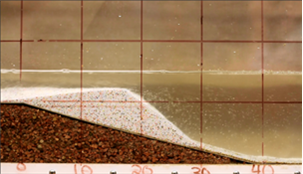Reports: DNI854492-DNI8: Morphologic Prediction of Reservoir Quality in Deltaic Stratigraphy
Brandon J. McElroy, PhD, University of Wyoming
| | | | | | | | | | | | | | | | | | | | | | | | | | | | | | | | | | | | | | | | | | | | | | | |
Initial deposition at start of experiements. Fully developed Gilbert Delta aggrading
above original topset elevation.













